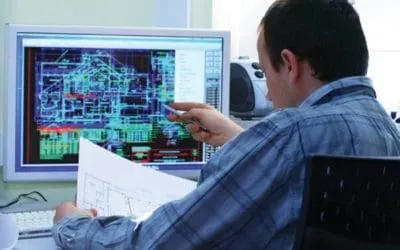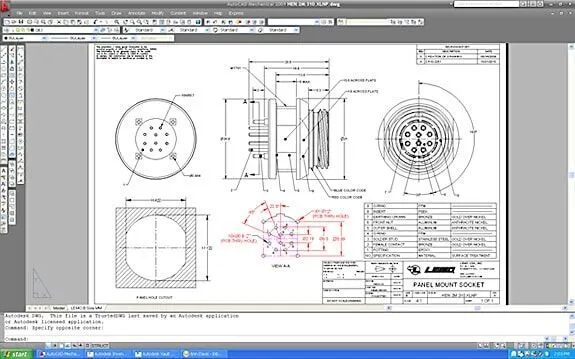The Importance of Raster to Vector in Large Format Scanning

If you have any number of hand-drawn engineering drawings, you should start converting them. Going through a scanning process then a raster to vector conversion can save your team a lot of time and money. How does it work? In this guide, we’ll answer that question by explaining the importance of large format raster to vector conversions.
Definitions of a Raster Image and Vector File
Before getting too far, let’s get some definitions out of the way. Specifically, what is a raster image and a vector file?
A raster image is a collection of dots, or pixels, on your screen. It’s what you get after scanning a picture and creating an image file, or after taking a picture of a drawing and emailing it to yourself. Sure, the picture on your screen looks just like the engineering drawing on paper, but the raster image is nothing more than a ton of little dots on your screen.
A vector image is a lot more powerful. It includes lines that have a position, length, and space in X and Y. Why is this so important? Because a vector image contains usable data that any CAD program can work with. If you create three lines and connect them, your CAD program understands this shape as a triangle and it can do things like measure the lengths, measure the angle, or extrude it into a 3D shape.
None of these steps can be done with a raster image, just a vector file.
What Is Large Format Raster to Vector Conversion?
A large format raster to vector conversion is when you take a large hand-drawn engineering drawing and transfer it into a usable 2D CAD model. It entails scanning the drawing with a high-quality scanner, then fully converting that file into a vector file.

The Importance of Large Format Raster to Vector Conversions
We have converted millions of raster images into vector files over the years, and plenty of them were large-format drawings. Why is this conversion so important? There are a number of reasons to discuss:
Upgrade Your Legacy Drawings
A common problem with legacy drawings is that you can’t do anything to them. It’s incredibly hard to update a hand-drawn drawing, and it’s even harder to preserve the original drawing during these upgrades. As a result, a lot of companies shrug their shoulders when it comes to upgrading or tweaking a design — for instance, adding new bolt holes to a legacy grinding machine so a new motor can be mounted to it.
If you first convert the drawing into a vector image, then you can upgrade the design in no time at all. Then, it’s just another CAD file that you can adjust however you’d like. You can still save the original design while adding different configurations to future-proof your legacy parts.
Protect Your Older Intellectual Property
Another issue with old hand drawings is that they’re tough to keep intact. Any amount of water or fire, a robbery, or simply losing a drawing can be devastating. A lot of companies don’t have copies of their old drawings — once it’s damaged, that’s it. You just lost your old IP and you’ll have to try to recreate it.
Alternatively, you can start by converting your old designs into 2D CAD. By using a large format scanner, creating a raster image, then converting to a vector file, you don’t have to worry about old drawings going missing or getting too damaged to use.
This is imperative for any company that still relies on older designs in order to operate.
Easily Share, Collaborate, and Use Drawings
The raster-to-vector conversion of your large format drawing will fully digitize your part. Now, your part can be stored on a local server.
When you do that, anyone who has access to the server can open the drawing, record any changes, and send the part out for a quote. You can have multiple people open the drawing at the same time. This allows your sales, planning, and design teams to all open the same drawing and perform their respective job duties.
If you tried doing the same process with an old drawing, there would be a lot of frustration. Only one person can use a Mylar drawing at a time, so you’ll encounter a bottleneck.

Create 3D CAD Models as Needed
The best way to make a 3D model of your hand-drawn design is to start with a raster to vector conversion. In fact, this is how our in-house experts do this process every day. With a high-quality vector image, you can have it open on one screen while you create the 3D model on your other screen.
Setting up your workstation this way will save you time and money, and it will avoid any minor issues that you would have if you tried reading the Mylar drawing and creating the model instead.
With a 3D CAD model of your part, you can optimize your workflow. Speed up manufacturing, remove errors in fabrication, make installation easier, and show your clients exactly what the part looks like. You can even use the part to create a 3D digital twin of your facility.
It all starts with a conversion.
Conclusion
As you just learned, a large format raster-to-vector conversion can save your team a lot of time and money. The process is more difficult than you might think, but you can turn to our pros at CAD/CAM Services to take care of it. Our highly trained engineers will create CAD Perfect conversions so you can get quicker results without overspending. Get a free quote today.
Recent Posts


CAD Outsourcing Doesn’t Have to Be Done In India
CAD Outsourcing Doesn’t Have to Be Done in India Do a Google search for “CAD Outsourcing” and what you’ll find is lots of firms located in India, which is fine if you’re prepared to go off-shore for CAD services. But what if your U.S. based company prefers to stay a...

AutoCAD Fiber Optic Designs & Drawings
Before proceeding forward in explaining the affinity between AutoCAD and Fiber Optic, it would be prudent to rationalize the utility of optical cables. When communicating between systems, either via the internet or via an internal network system, a medium needs to be...

CAD Outsourcing: How to Get the Most Out of Engineering
In today’s competitive market, companies need as much help as possible. If you want to take a larger market share, you can start by outsourcing some of your work. This is a quick way to expand your engineering power without onboarding and training a new staff. This...
